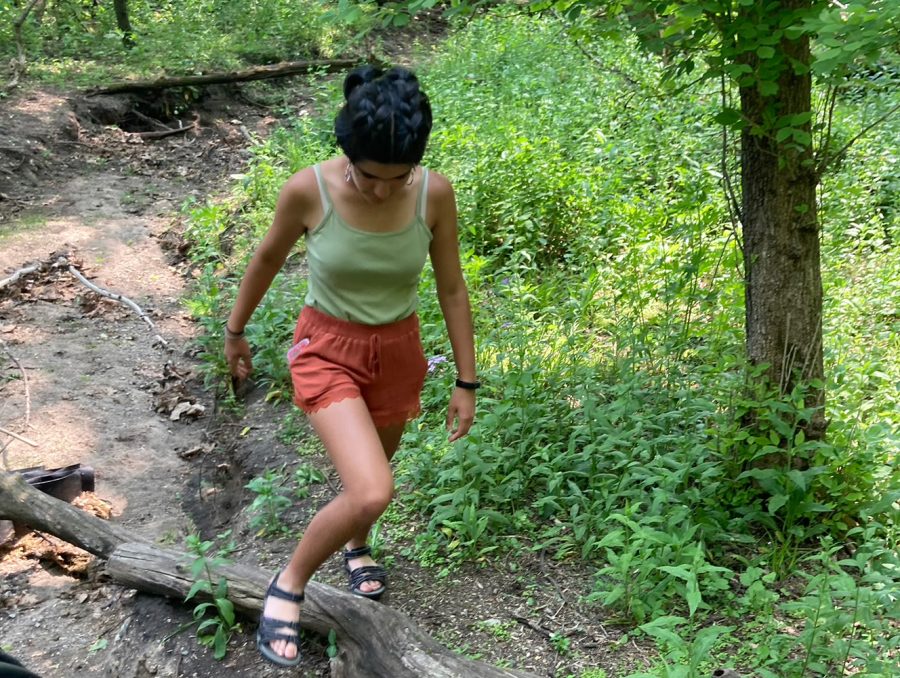Urban residents embrace green spaces: possibilities and benefits
Credit: Nora Duffy
Loy Norrix junior Nina Holm takes a walk in the Kleinstuck Preserve as a way to round out the weekend. She likes to take walks here often, especially as a way to meet up with friends and get fresh air.
June 8, 2023
The sound of birds and the smell of trees after rain fill the air. Water drips from the leaves onto the muddy ground of the Kleinstuck Preserve on a humid spring afternoon. Even though the preserve is in the middle of Kalamazoo, it is almost impossible to tell there is a city surrounding it.
People who live in Kalamazoo have easy access to more than 30 lush, green spaces like this one. Much of the local nature is made up of parks and preserves, and more people are starting to take advantage of alternative options such as vertical farming. Even though Kalamazoo is an urban area, there are many ways to interact with nature without leaving the city.
“Even if I’m not like walking in Kleinstuck or anything, I’ll just walk around the neighborhood. There’s still a lot of trees and whatever, so I’m in nature technically,” stated junior Nina Holm.
Spending time outdoors is something that Holm enjoys casually. She likes going biking with her dad in places such as Al Sabo Land Preserve and Maple Hill Trail. The latter is her favorite to bike on because of the tabletop hills.
“Sometimes if you go fast enough you can get some air,” said Holm, “which is kind of scary, but it’s fun.”
In addition to biking, Holm spends time outdoors walking around her neighborhood and playing sports such as tennis and ultimate frisbee. She believes that natural spaces can be preserved through small efforts such as picking up trash and growing native plants, which her family has in their yard.
“If you have the time and capabilities, you could do native planting like my mom does,” said Holm, while recognizing that this is a time consuming project. “Little things count. It’s not just big things.”
In addition to the many local parks, there are also other ways to create green spaces. Various forms of urban farming have been growing over the years as cities expand. There are a number of community gardens within Kalamazoo including the Oak Street Community Garden and the WMU Community Garden, to name a few.
Rooftop and vertical farming are other kinds of urban farming on the rise. These creative methods are expected to continue to grow and help meet the needs of people living in urban areas.

Life science teacher Eric David believes that while Kalamazoo has more nature than some places, there could always be more creative ways of creating green spaces.
“[We should be] integrating nature in urban spaces as opposed to here’s a park and here’s a bunch of buildings,” said David.
In addition to bringing nature into urban areas, vertical farming makes it possible for agriculture to take up less space. If it were a more accessible option, senior Georgia Hutton would take advantage of vertical farming due to the large amount of space and plastic that local greenhouses take up.
“Vertical farming, it’s really cool because it takes up no space. I work in a greenhouse and it’s huge. There are people who bring bikes to work, so they can get to different places in the greenhouse,” said Hutton.
According to Vertical Farming for the Future by Sarah Federman from the United States Department of Agriculture, “Providing fresh greens and vegetables close to these growing urban populations could help meet growing global food demands in an environmentally responsible and sustainable way by reducing distribution chains to offer lower emissions, providing higher-nutrient produce, and drastically reducing water usage and runoff.”
Urban farming has potential to bring fresh produce to urban areas as well as provide them with green spaces that might otherwise be hard to come across in a landscape that doesn’t include much nature.
Local speech therapist Liz Griff runs her own container garden in her yard, where she grows a variety of vegetables and herbs such as tomatoes, potatoes, okra and more. The garden is based around the environment it’s placed in.
“It’s a container garden, which I like because when things are small, if bad weather is coming, you can move them out of the way, and it’s using the environment,” said Griff. “I’m using the fence for trellises, and I might tie things up to the house this year”.
Local urban farming also promotes food independence, which can be enhanced through community organization. What is Food Security? What is Food Independence? from Fillmore Containers Blog defines food independence as a household, or group of people taking part in growing and harvesting their own food to cover everyone’s needs independently from other sources. This is one way that people can shed the need to worry about how much cash they have for food, a common problem in urban areas, according to Growing Cities, Growing Food Insecurity: How to Protect the Poor during Rapid Urbanization by Marie Ruel from the Center for Strategic and International Studies.
Other benefits of urban farming include having ready access to fresh food, and having a lot of extras to make it through the winter, all with 15 minutes of daily maintenance.
“We have a dehydrator and a freeze drier, so there are lots of ways that you can tuck the stuff that’s fresh right now away so that you can access it later, getting all the benefits of the garden all year round,” said Griff.
Having ready access to a garden educates people about what grows near them and where food comes from. This would help increase the nutrition of everyone who can get food from a local source and provide the community with extra produce.
“I think it would get kids more involved in what they’re eating. When I was a school speech therapist, a lot of kids didn’t know what origin foods were. They knew what french fries were and they knew what potato chips were, they knew what tater tots were, but they didn’t know what a potato was. They definitely did not know what mushrooms were. Everything red and round was an apple,” explained Griff. “I think we would certainly increase the nutrition of everybody who could get the food from that.”
Urban farming can be as simple as a small garden in one’s yard and require little maintenance, but there are so many possible health benefits if it were to become more widespread. Natural areas that don’t produce food also create opportunities for better health.
The benefits of living near green spaces include opportunities for physical activity and wellness both mentally and within the community. Being outside in nature removes some risk of depression and increases the ability to focus while also lowering the possibility of cardiovascular disease, according to The wellness benefits of the great outdoors by Andrew Avitt from the US Forest Service.
Going outside certainly isn’t a cure all, but it can help take the edge off when things get tough.
Hutton said, “My mental health is kinda bad, so going outside makes it slightly better.”
Going outside relieves stress and gives people access to fresh air that they may not experience much on a daily basis indoors. There are many cognitive benefits as well as emotional benefits that lead to increased enjoyment of life in spaces untouched by the stress of work and school.
“It’s good to slow down the pace of life for a little bit,” said David, referring to the benefits of the outdoors.
Students should visit the green areas near them and maybe even try to learn a thing or two about the space. Because these do so much good for the community, it is also helpful to give back and play an active role in maintaining natural spaces whenever possible in order to keep them available for future generations as well as for plants and animals.










